Questions
This guide provides comprehensive instructions on creating and managing survey questions. It includes steps for adding various question types, entering and formatting question text, and adding descriptions with diverse formatting options. Users can configure common properties, apply logic actions based on responses, and enhance questions with multimedia attachments. It also covers reordering, duplicating, and removing questions, and provides a detailed overview of the available question types and their uses, ensuring effective survey design for capturing valuable feedback.
Quick Guide
Adding Question
To add a question to your survey, navigate to the Content section and click on the + button. This will allow you to add different types of questions to your survey, such as voice responses, multiple-choice, text inputs, and more.
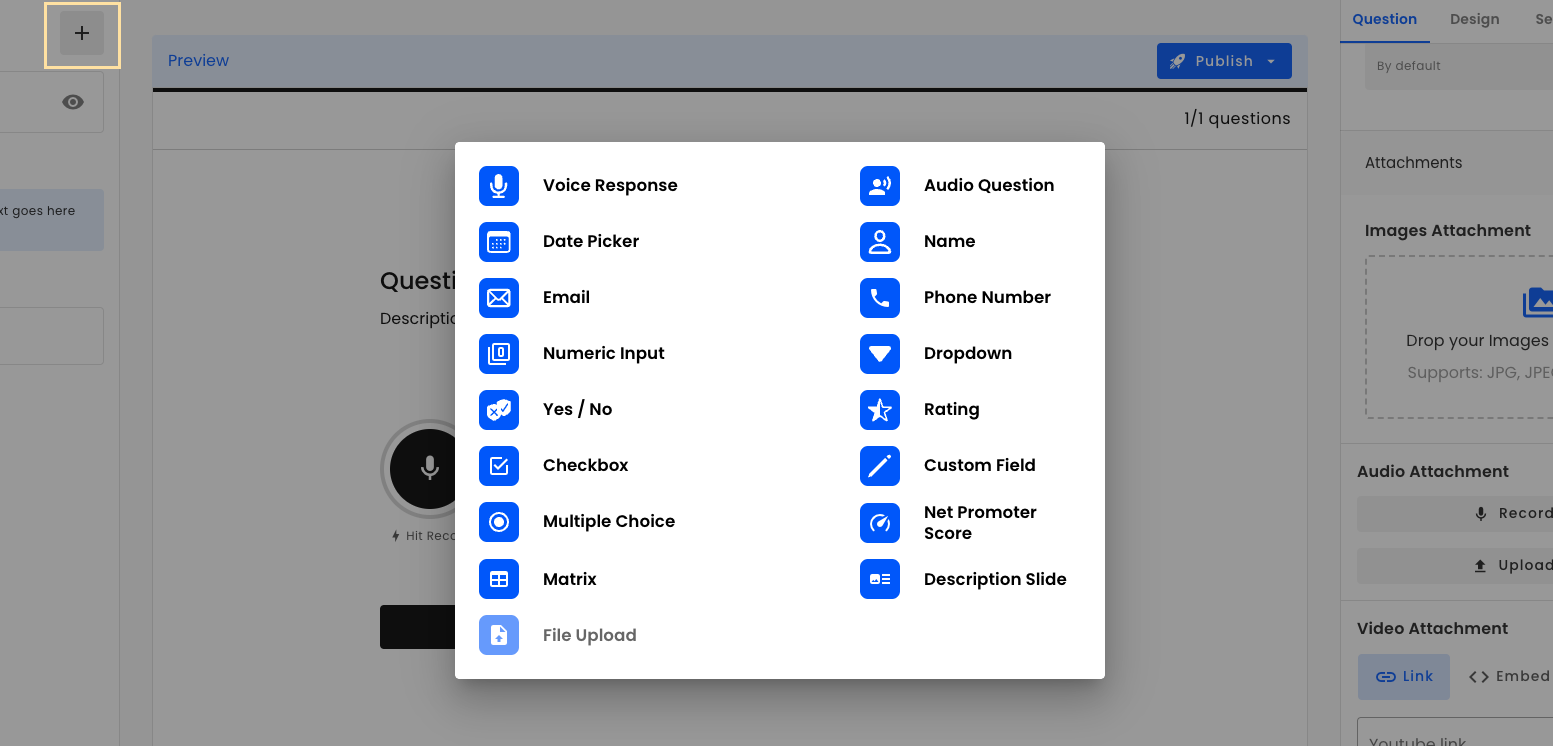
Adding Question Text
For each question, you can enter the question text and an optional description. This helps to provide context or additional instructions to the respondents.
Click on the question field labeled “Type question here ”. This is where you enter the main question text that you want respondents to answer.

Adding Description
Below the question text field, there is an option to add a description. This is useful for providing additional details or instructions related to the question. The description can include formatting such as headings, bullet points, numbered lists, block quotes, images, and dividers.
Formatting by Selection
To format the text, simply select the text you want to format and choose the desired formatting option from the toolbar.\

Formatting Option | Description | Keyboard Shortcut |
|---|---|---|
Bold | Highlight important text by making it bold. |
|
Italic | Italicize text to emphasize or distinguish it. |
|
Underline | Underline text for additional emphasis. |
|
Strikethrough | Strike through text to indicate deletions or changes. |
|
Text Alignment | Align text to the left, center, or right. | Align Left: Align Center: Align Right: |
Link | Add hyperlinks to external resources or related content. |
Adding Components by Typing /
/You can trigger the components list by typing / in the description field. This will display a list of components you can use to enhance your question description.
Available Components:
• Headings: Organize information hierarchically with Heading 1, Heading 2, and Heading 3.
• Lists: Create bullet points or numbered lists to itemize information clearly.
• Blockquotes: Highlight important information or quotations.
• Images: Embed images within the description to provide visual context or examples.
• Dividers: Use dividers to separate different sections within the description for better readability.

Common Question Properties
In addition to setting the question text and description, you can configure several common properties for each question to tailor it to your needs.
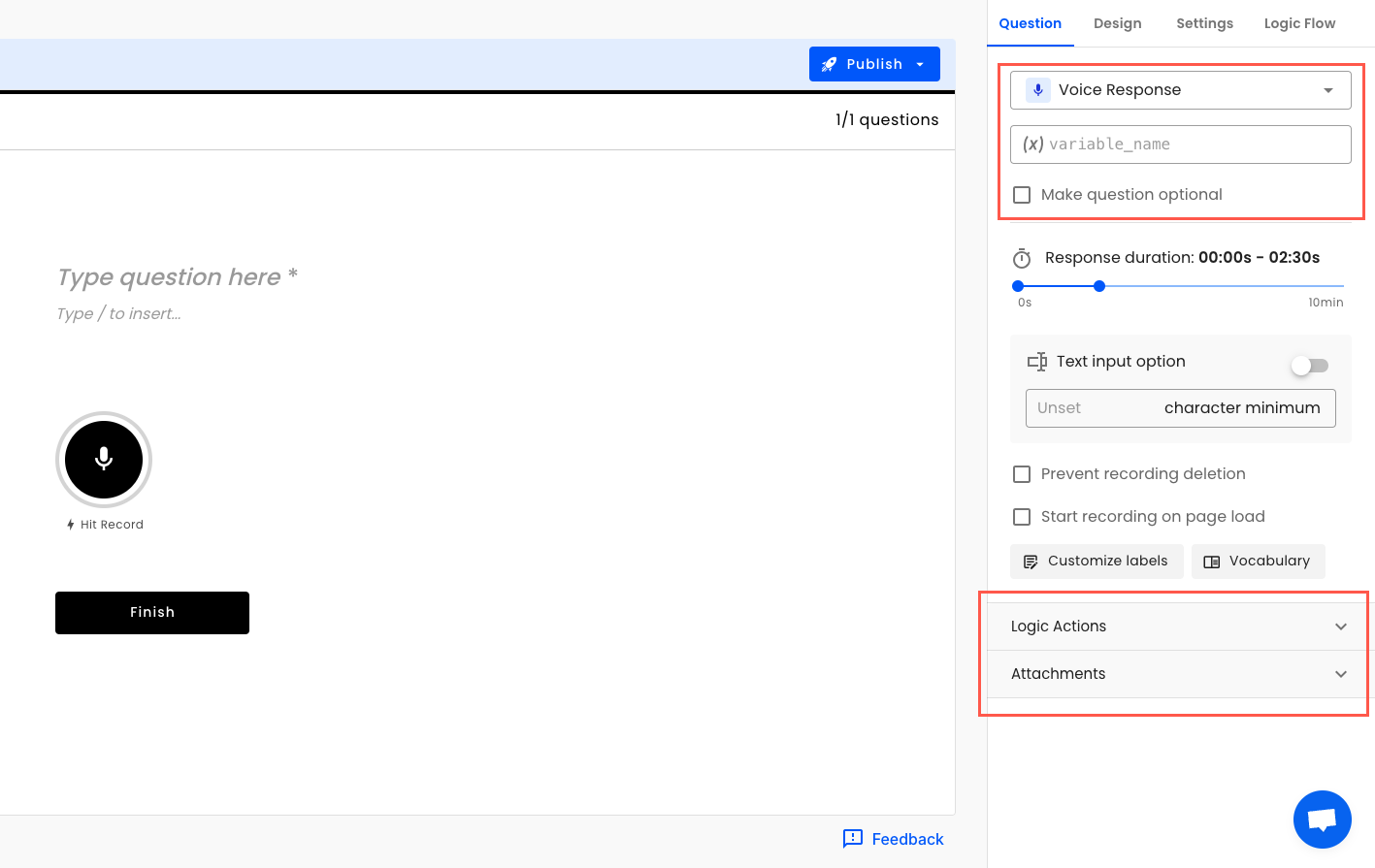
Switching Question Type
You can switch the type of question by selecting the desired question type from the dropdown menu at the top of the question settings panel. This allows you to change a question from a voice response to a text input, multiple-choice, or any other supported question type without losing the existing content.
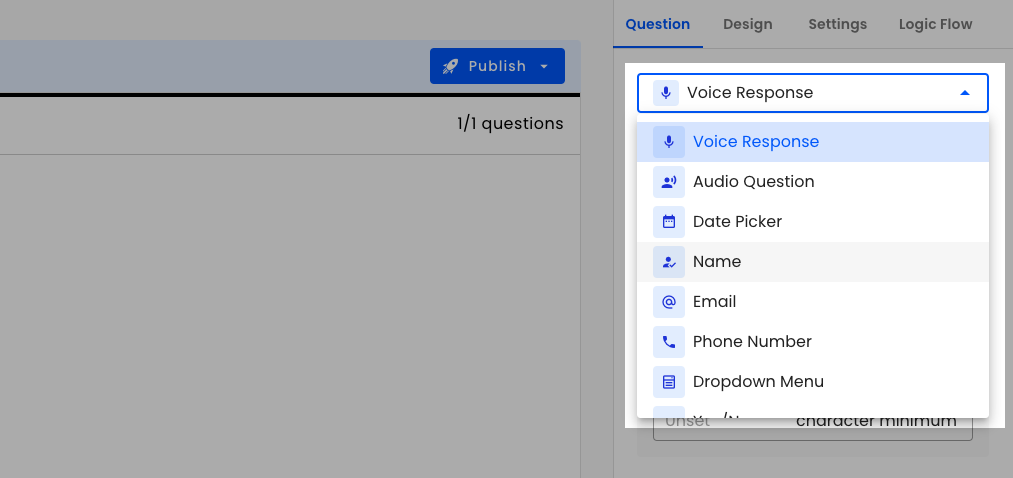
Switching Question Type with AnswersThe way how question switch is working is it removes an existing question and and creates new oneon the same spot. Question switching will try to automatically duplicate common question properties but answers to an old question will be removed because they won't be applicable anymore to the new type.
Making Question Optional
To make a question optional, check the box labeled “Make question optional” in the question settings panel. This allows respondents to skip the question if they choose, providing flexibility in how they answer the survey.
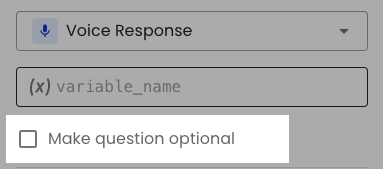
Note: If a question is optional, it will remove the* requirement symbol from the end of the main question text.
Assigning a Variable

Assigning a variable name to a question allows you to reference the response data easily in your analysis. Enter the variable name in the field labeled variable_name in the question settings panel. After that, the variable can be accessed via double curly brackets syntax {{}}. For example, if variable_name was favourite_fruit, accessing this variable will be {{fields.favourite_fruit}}.
Fields VariablesFor more details on variable capabilities, please refer to the dynamic variables page.
Logic Actions
Logic actions allow you to define what happens based on the respondent’s answers. This can be used to skip questions, display additional questions, or perform other actions based on specific responses. To add a logic action:
- Expand the Logic Actions section.
- Click on + Add action.
- Define the action and condition.
Logic & ActionsFor more information on how to define the logic, please refer to theLogic & Actions page
Attachments
You can add various types of attachments to your questions to enrich the survey experience:
Image Attachments
Drag and drop images or click browse to upload images. Supported formats include JPG, JPEG2000, PNG, and GIF.
In comparison with the description / Image component Image Attachments are used to list multiple images in a row. Each image is assigned a number and if you click on it, it exapnds in to carusel image preview.

Audio Attachment
Record audio directly or upload an audio file. This is useful for adding voice instructions or examples.
Play Audio on Page Load
If the “Play Audio on Page Load” property is enabled, the attached audio will be played when the respondent lands on the question step.
First Question StepNote that if the question step is the first thing the respondent sees, the audio won’t start playing. This is the default browser behavior.
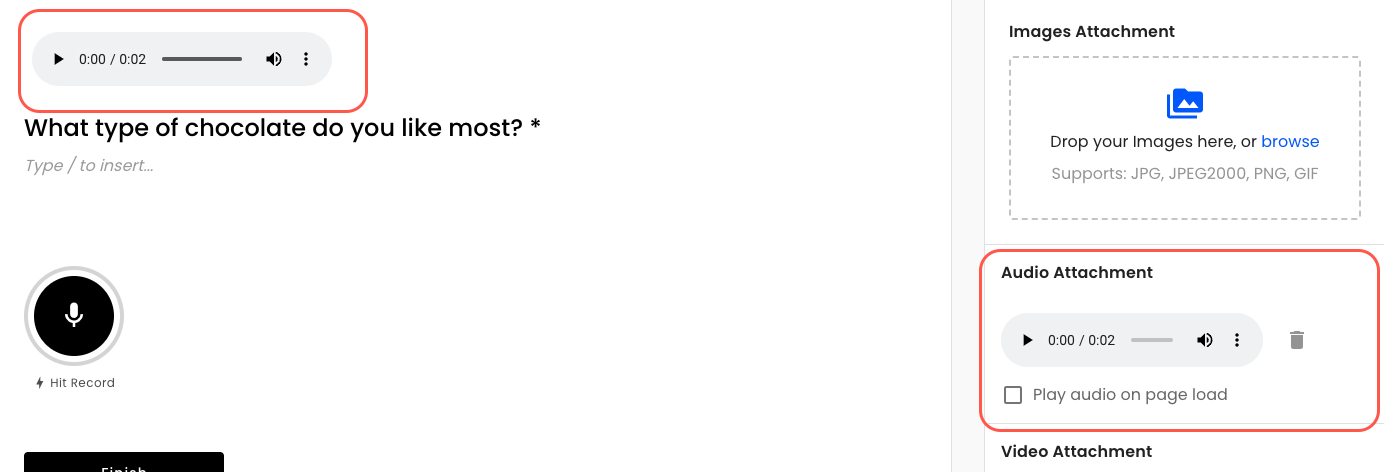
Video Attachment
Provide a YouTube link or embed a video. Videos can help in providing detailed instructions or visual context.
YouTube Link: Provide a YouTube link to embed a video directly from YouTube.

iFrame Embed: Embed a video by passing an iframe code. This allows you to include videos from other sources or with custom settings.

Left Side Content Panel
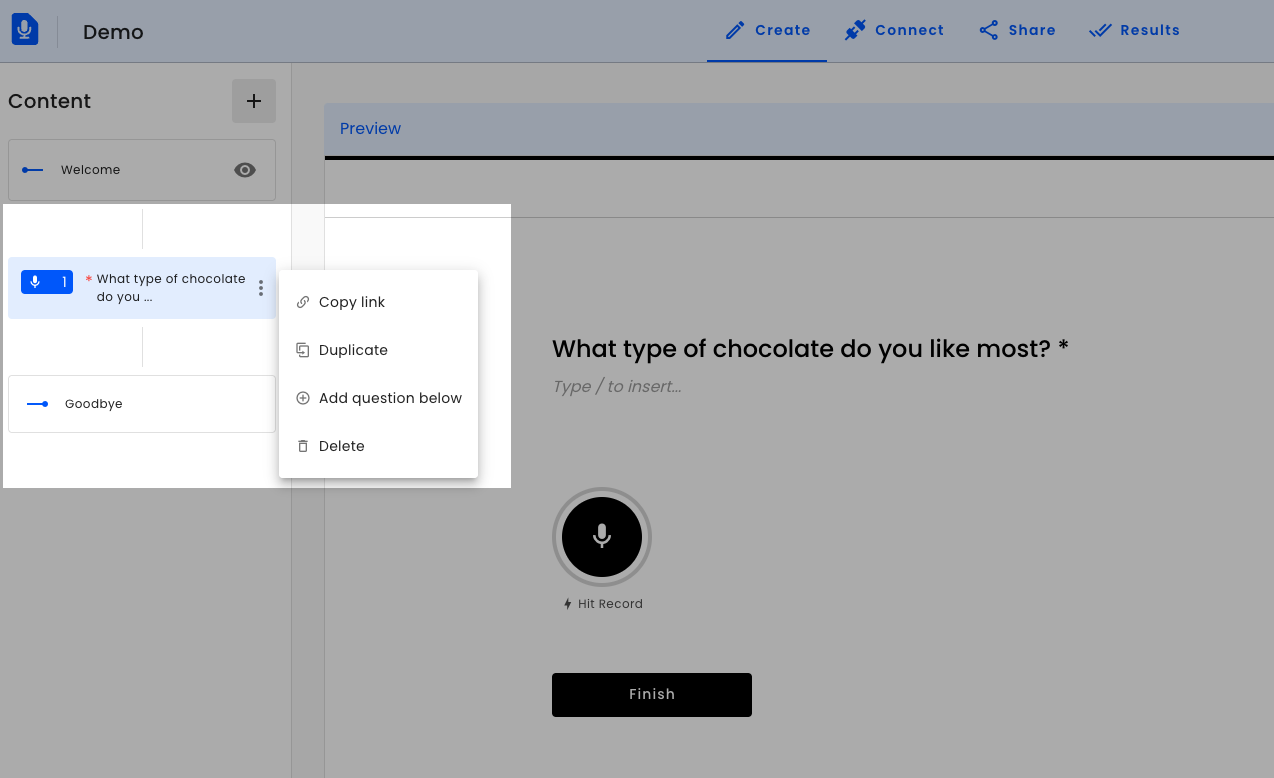
Reordering
To reorder questions, drag and drop the questions in the Content panel on the left side of the screen.
Adding Question Bellow
To add a question below an existing one:
- Click on the three dots next to the question.
- Select
Add question below.
Duplicate Question
- Click on the three dots next to the question.
- Select
Duplicate.
Removing Question
- Click on the three dots next to the question.
- Select
Delete.
Removing QuestionIf a question contains any answers, these answers will be removed along with that question.
Available Question Types
There are more properties related to each question type. Please refer to the list of available questions:
| Question Type | Description |
|---|---|
| Voice Response | Allows respondents to answer the question using their voice. Useful for capturing detailed, nuanced feedback. |
| Audio Question | Respondents can listen to an audio clip and then provide their response. Ideal for auditory-based questions. |
| Date Picker | Allows respondents to select a date from a calendar interface. Useful for scheduling, event planning, or date-specific questions. |
| Name | A text field specifically designed for collecting the respondent’s name. |
| A text field validated to ensure the input is a valid email address. Useful for collecting contact information. | |
| Phone Number | A text field validated to ensure the input is a valid phone number. Useful for collecting contact information. |
| Numeric Input | Allows respondents to enter numeric values. Useful for questions requiring numerical data. |
| Dropdown | Provides a list of options in a dropdown menu. Respondents can select one option from the list. Useful for limiting choices to predefined options. |
| Yes / No | A binary choice question where respondents can select either “Yes” or “No.” Useful for straightforward, dichotomous questions. |
| Rating | Allows respondents to rate something on a predefined scale, such as 1 to 5 stars. Useful for gauging satisfaction or opinion. |
| Checkbox | Provides a list of options with checkboxes. Respondents can select multiple options. Useful for questions allowing multiple answers. |
| Custom Field | A flexible field that can be customized for various input types, such as text, numbers, or dates. Useful for unique data collection needs. |
| Multiple Choice | Provides a list of options as radio buttons. Respondents can select one option. Useful for questions with single-answer choices. |
| NPS (Net Promoter Score) | Measures customer loyalty by asking respondents to rate the likelihood of recommending a product or service on a scale of 0 to 10. |
| Matrix | Allows respondents to evaluate multiple items using the same set of response options, often displayed in a grid format. Useful for comparing multiple attributes or features. |
| Description Slide | A non-interactive slide that provides information or instructions. Useful for giving context or details before subsequent questions. |
| File Upload | Allows respondents to upload files. Useful for collecting documents, images, or other files relevant to the survey. |
Updated 8 months ago